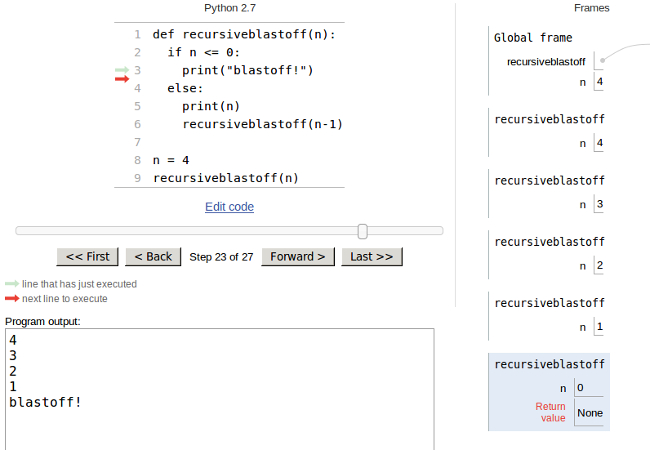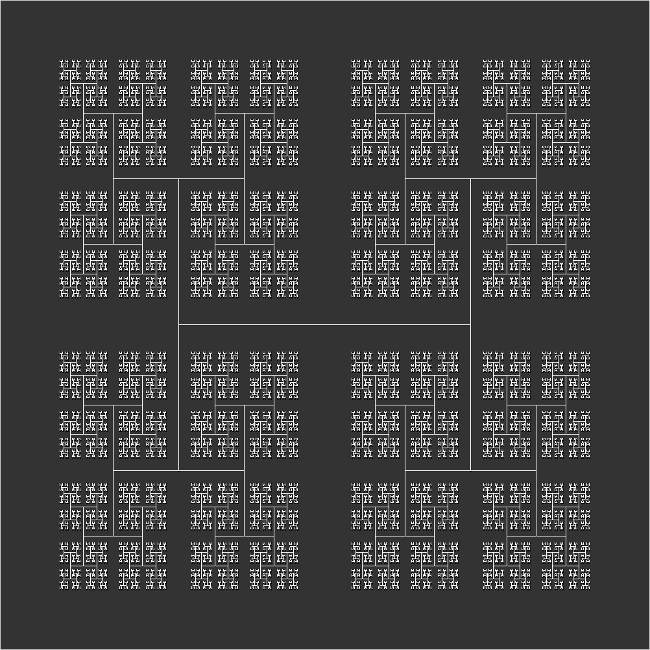
recursiveblastoff stack frames
Recursion is when a function calls another copy of itself to finish the work. Some algorithms, like the merge sort (or any divide-and-conquer algorithms), are more easily expressed using recursion. This week we will practice writing recursive functions.
Obviously, if the function calls another copy of itself, the other copy may call yet another copy, and so on. This leads to repetition, very similar to a loop. In fact, designed correctly, a recursive function can simply replace a for loop. So all of the functions we have written so far (sum a list, blastoff, find the max of a list, etc) can be written using recursion (and not using a for loop or a while loop).
Here is the simple blastoff(n) function, to show a countdown from some number n, using a for loop:
def blastoff(n):
for i in range(n,0,-1):
print(i)
print("blastoff!")Thinking recursively, you may notice that blastoff(10) is really just this:
print(10)
blastoff(9)And blastoff(9) is this:
print(9)
blastoff(8)And so on. The key to writing an algorithm recursively: handle the first item or case, then let recursion handle the rest. For the above, given an integer n, we would:
print(n) # take care of n
blastoff(n-1) # let recursion handle the restAlso note, each subsequent call to blastoff() has a smaller value of n. Eventually we will call blastoff(2), then blastoff(1), and then, finally, blastoff(0). At that point, we want to just print "blastoff" and stop the recursion. This is formally called the base case, and is usually written with an if/else clause.
Here is the full recursive blastoff function:
def recursiveblastoff(n):
if n <= 0:
print("blastoff!")
else:
print(n)
recursiveblastoff(n-1)Notice the base case stops the recursion (does not call another copy). Also notice the non-base case (the else clause) heads toward the base case by calling another copy, but with n-1 as the argument.
Sometimes, to understand recursion, it helps to think about the stack frames. If the above function were called with n=4, how many frames would be put on the stack? Try it in the python tutor! Here is a screenshot of the stack frames, when the recursion has reached the base case:

recursiveblastoff stack frames
Here is another example, this one from mathematics: the factorial(n) function is defined as n*n-1*n-2*...*3*2*1. So, for example, factorial(5) is just 5*4*3*2*1. Notice, however, that factorial(5) can be written as just 5*factorial(4), since factorial(4) = 4*3*2*1. If factorial(0) = 1, can you write a recursive factorial function? You can test your function against the factorial function in the math library:
>>> from math import factorial
>>> factorial(5)
120
>>> factorial(8)
40320Note: both the factorial() and the blastoff() functions can easily be written without using recursion. We are just using them as simple examples. This week we will try to write as many recursive functions as we can, just to learn recursion and get used to thinking recursively. Later in the week we will look at some algorithms that are more easily expressed using recursion.
I think the hardest part about writing recursive functions is the first step, where you need to express the problem in a recursive fashion. Try to keep the following in mind: handle the first case, then let recursion handle the rest. Once you have that part figured out, it is usually easy to write the base case. Let's try a few examples:
Given a list of numbers, L, write a recursive function (no for loops!) to sum the list and return the result.
The first step is usually the hardest...the sum of a list is just L[0] + the sum of the rest of the list. Using python slicing, it is easy to grab the rest of the list: L[1:]. If sum(L) calls sum(L[1:]), what is the base case we are heading toward? And if we reach the base case, what should the function return?
Given a positive integer n, flip a coin n times and return the number of heads flipped. Write a recursive coinflip(n) function (again, no for loops!).
Note that n flips is just one coinflip plus n-1 more flips. So our function, in the non-base case, needs to flip 1 coin, figure out if it was heads or tails, then let recursion flip the other n-1 times, add those to the result of the first flip, and return the full result.
Each subsequent call to coinflip() has one lower value of n, so what is the base case?
Given a list of numbers, L, and a value, x, write a recursive function to count how many of x are in L. For example, calling count(range(10), 99) would return 0, and count([1,2,8,2,2], 2) would return 3.
Again, handle the first item in the list, L[0], then let recursion handle the rest of the list (L[1:]).
Here is the isSorted(L) function from last class:
def isSorted(L):
"""return True if list is in sorted order, low to high"""
if len(L) <= 1:
return True
else:
# check L[0] vs L[1]
if L[0] > L[1]:
return False
else:
return isSorted(L[1:])For the base case, we know the answer: a zero- or one-element list is obviously sorted, so return True.
For the non-base case, just check if the first two are in order. If not, we can immediately say the list is not in order (return False). If the first two items are in order, make the leap of faith: isSorted(L[1:]) will give us a True or a False, if the rest of the list is sorted or not, so just return whatever we get back from that recursive call.
Finally, now that we understand recursion a little better, here are some examples that are "naturally recursive". These are algorithms that are easier/more elegant to write using recursion. Again, you could write them iteratively (using loops), but sometimes it makes more sense to use recursion (not always!).
Here is an interesting picture. Can you see the recursion? What happens first, and what is the base case?

H recursion picture
Using Zelle Graphics, first write a function called H(win, pt, size) that draws a single "H" in the given graphics window, at the given Point pt, with the given size. For example, calling H(win,Point(100,100),50) would draw an "H" at the coordinates (100,100) with size 50.
For the "H" function, you will need to create Line() objects using other Point() objects. Using the clone() method will definitely help:
>>> from graphics import *
>>> pt = Point(100,100) # assume we are given these
>>> size = 50 # assume we are given these
>>>
>>> p1 = pt.clone()
>>> p1.move(-size,-size)
>>> p2 = pt.clone()
>>> p2.move(-size,size)
>>> leftedge = Line(p1,p2) # create left edge of the H
>>> leftedge.draw(win)Once you have a working H() function, can you use it to draw one "H", then another at point p1? And another at that H's p1? And so on...
What is the base case for the recursion? What happens when the size gets too small? Also, how many times do we need to recur to get the four H's at the four corners (points p1, p2, and so on)?
There are many interesting examples of recursive graphics algorithms. Take a look at some of these links and see if you can understand how they recur:
Here is the mergeSort() algorithm from last week:
def mergeSort(L):
"""use merge sort to sort L from low to high"""
if len(L) > 1:
# split into two lists
half = len(L)/2
L1 = L[0:half]
L2 = L[half:]
# sort each list
mergeSort(L1)
mergeSort(L2)
# merge them back into one sorted list
merge(L1,L2,L)For this one, the base case is not explicitly written. It just does "nothing" if the length of the list is one or less.
Any divide-and-conquer algorithms, like the merge sort, can usually be expressed easily using recursion.
Since merge sort simply divides the original list in half, then each subsequent list in half, and so on, part of the big-O notation must be logN, because that's how many times we can divide a list of size N in half. The other part of merge sort is to merge them all back together. Given two sorted lists, the merge operation just compares the first items in each list. This will require at most N compares, so it's not hard to see that the merge sort is an O(NlogN) algorithm. This is better than all of the quadratic sorts we looked at last week (bubble, selection, and insertion sort).
Here is a nice picture from wikipedia of what happens during the merge sort.
And here are some timings (for initially random lists of N integers) of various sorts we have looked at:
$ python timesorts.py
N: 2000
selection sort time: 0.1435
bubble sort time: 0.4378
python sort time: 0.0003
merge sort time: 0.0090
$ python timesorts.py
N: 4000
selection sort time: 0.5572
bubble sort time: 1.7164
python sort time: 0.0007
merge sort time: 0.0188Notice the time for the merge sort does not quadruple like the selection and bubble sort times. Also, python's built-in sort seems to be the best. What algorithm does the built-in sort use???